Get Your Business Ready for 2021. Insights & Trends

We’ve looked at what’s bound to happen to businesses in 2021 in terms of their products, marketing, and communications. We sorted out analytical reports of digital marketing leaders and we’re happy to share the most important trends with you!
Altimeter, The 2020 state of digital marketing
Automation and digitalization are key business drivers despite cost reduction amid the pandemic. The key objective of digital marketers is to acquire more customers and encourage repeat purchases. Thanks to big data and artificial intelligence, you can personalize your communications and deeply segment users.
Wondering what this means?
New level of segmentation and personalization
Segmentation and personalization are now an industrial standard as over half of respondents say personalization is their top digital marketing priority and 37% put segmentation first, though it’s directly connected to personalization.

These processes become more tech-savvy and data-driven.
As the report says, a third of all companies invest in new digital channels: IoT, voice assistants and dictionaries, AR/VR technologies, video retargeting, and so on.
With that, 24% of businesses implement various automation and data exchange solutions.
A highlight: a mere 2% of digital marketers are willing to rearrange their marketing teams to enhance their performance.
Personalization and omnichannel approach
More and more companies tend to personalize customer experience and use the integrated CJM to ensure seamless interaction of all internal teams with customers. When it comes to customer insights, we see artificial intelligence coming into play. Companies with AI onboard can get much closer to customers with their content, communications, products, and the overall customer experience.
Personalization and meeting customer needs are key to stand out and acquire customers amid infoglut. Hi-tech is cool, especially AI, but still only large corporations can afford to use them.
However, it doesn’t mean that advanced personalization and segmentation are unavailable for medium and small businesses. There are mass-market tools that help track user behavior and see what they are interested in. A sales rep can make a better offer using these data.
Read also:
- Customer VS Client — making the difference clear
- Why eCommerce and omnichannel are inseparable?
- How to qualify lead within sales and marketing teams
- Ultimate guide to inbound lead qualification in EdTech marketing
- How to Qualify and Collect More Leads with Lead Bot?
- How BANT sales process can help you get qualified SQL in 2022
Technology + innovation scaling = problems
Scaling expertise and practice is a major obstacle for digital marketers along with technology implementation and updates. You need new approaches to training and sharing expertise and a more advanced organizational structure.
All these things are not top priorities among marketers.
Purchasing and integrating the right martech (interactive solutions for data-driven marketing — Editor’s Note) platforms are still a challenge.
Read also: Find out the best Intercom alternatives
Over a half of all respondents highlight HR challenges as they find it difficult to hire competent specialists.
Digital marketing and transformation amid the COVID-19 pandemic
In 2020, companies differently addressed budgeting issues amid the pandemic. Some companies reduced their costs dramatically, but some, by contrast, decided to invest more.
With that in mind, marketing transformation of businesses is only accelerating. Over a fifth of all respondents continue to grow their businesses and speed up, and 30% of respondents said the crisis didn’t affect their transformation ambitions.
Big data and martech
Big data, automation, and technology will only grow in the future. They are not as easy as may seem despite their availability. Especially for marketing when it comes to evaluating software and integrating it in the current systems. The demand for martech and the related skills exceeds supply, and martech teams can’t pick up the desired speed.
A clear strategy and competent management are key to success in using data. Companies are still at the early stages in this respect.
32% of respondent companies move towards predictive analytics and there’s a large role for Data Science. These companies acknowledge the value of the data strategy and access to it.
20% of companies managed to make data strategy the key competence in some teams and are now focusing on rolling it out for the whole company.
The integrated customer journey is the key to fruitful communication
30% of respondents said they already had the integrated CJM for a better customer experience, another 30% were in the making.
However, 18% of respondents highlighted that each team designs its own CJM.
This means that the vast majority of businesses acknowledge the value of the integrated CJM, while the rest continue to cut it into pieces.
A mere 3% of companies don’t recognize the value of the CJM for a better customer experience yet.
You can’t design the CJM without data. So, you need various teams working together that interact with a customer: sales, marketing, product, implementation. Each team has expertize on their stages of the funnel, and if your CJM doesn’t have all these data, it’s just a fantasy, not an authentic map.
Content, channels, and media are the basis of digital marketing
Content, channels, and media are the heart of any digital campaign. Marketers need to update their strategies with the growing depth of personalization. However, it puts bigger pressure on content making teams as they have to create personalized content AND scale production.
Metrics — evaluate what’s influencing your business
Marketers shy away from likes and views when it comes to measuring content performance. Major metrics allow you to evaluate their impact on the company revenue.
A mere 15% of respondents still rely on content reach as a key metric. Most respondents — over a third — share a more holistic view of the content success. They evaluate how the content influences the customer journey and the actions customers take.
Read also: The North Star Metric and How Can This Lead to Success
22% of companies can directly match the content performance to the company revenue. This is the metric that clearly tells if technology is appropriate.
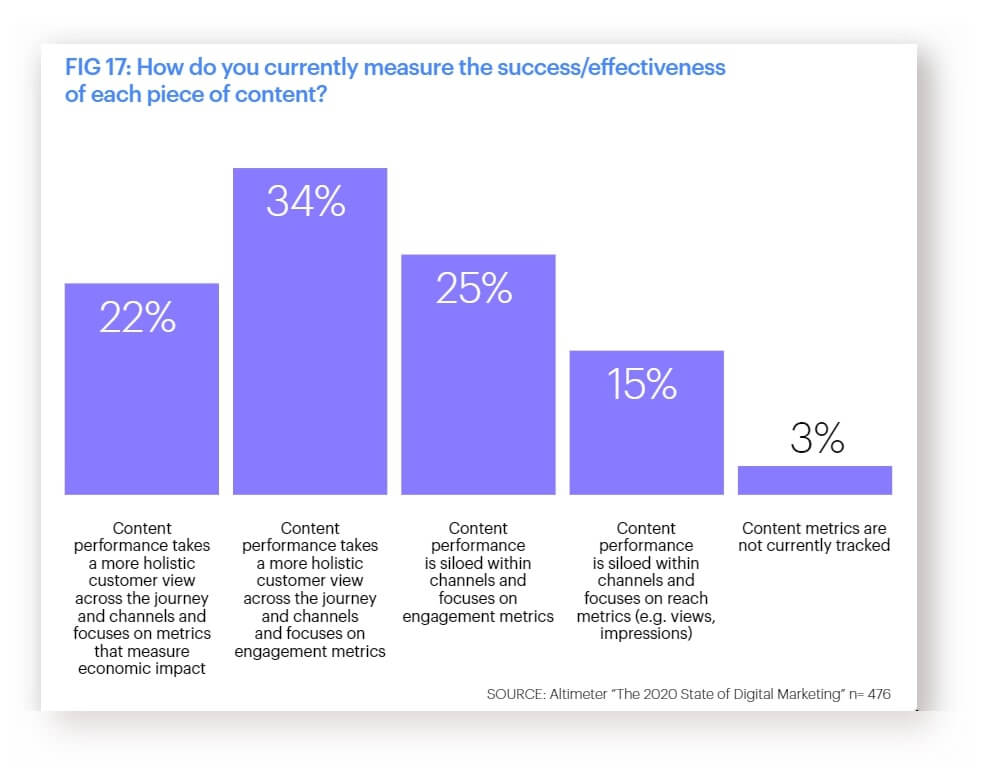
Ad spend is growing
Over a year, companies started to invest more in digital ads. Mostly, in Facebook targeted ads (62%), ads in mobile apps (58%), and display ads (55%).
Despite unpredictable algorithms and ambiguous advertising rules, Facebook is still the leader in targeted ads.
The duet of marketing and sales
Marketing and sales teams tend to become more interdependent. Two teams align on their goals, exchange data, and integrate software to improve their collaboration. The most important thing is to distinguish responsibilities while preserving close connections.
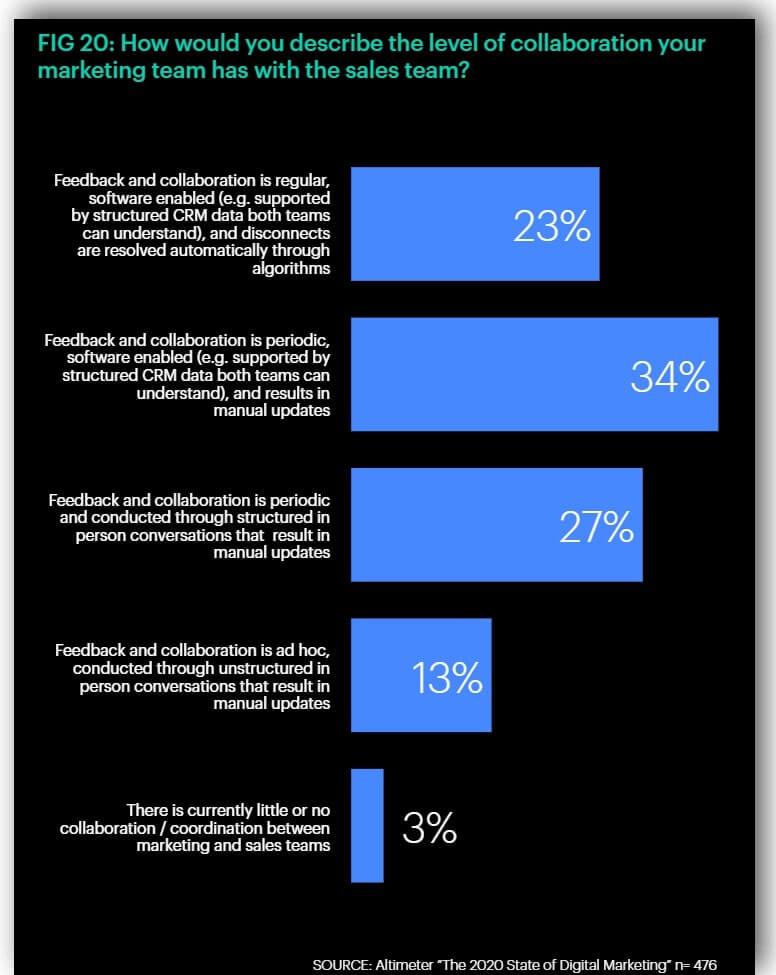
34% of marketers said they personally communicated with sales reps or both used the same CRM.
23% of respondents said they regularly talk to sales reps, and the communication process is well-structured thanks to mutual platforms.
Salesforce, State of the connected customer 2021
This report is based on over 12k consumers and 3600 businesses surveyed worldwide. It highlights changes happening in the way companies interact with customers due to a course of continuous crises. The authors emphasize that our lives and the “customer-company” interaction have changed dramatically during the pandemic.
Empathy, personalization, convenience, and digital transformation are the key to a fruitful relationship with a customer.
Communications during crisis
Customers are sensitive to how businesses react to their needs. If you interact poorly due to a crisis, you may lose customers regardless of the funnel stage.
Digital transformation has accelerated. People spend much more time online, and that changed their routine. Here are some replies of customers on what has changed during 2020.
63% of respondents said their shopping moved online, and 62% completely relocated their lives to online.
Customer experience is key when it comes to building relationships, not just generating sales. Businesses offering flawless service are twice as successful. Over half (53%) of customers say they feel emotionally connected to brands where they buy the most from.
The new thresholds of customer interactions
Customers moving online set higher interaction standards.
88% of respondents expect new digital products and services together with flawless service. Depending on the generation of your customers (millennials, baby boomers, or gen Z), their expectations may differ.
90% (!) of customers say the company’s behavior during the crisis reflects its reliability.
Compared to 2019, reliability has become even more significant in 2020 as 82% highlighted it vs. 73% a year ago.
Many customers had to move to online due to the pandemic as well as businesses. Since offline service implies direct contact of a customer and a manager, customer expectations regarding online service went up.
Our team worked during Christmas holidays. We knew we wouldn’t have a lot of requests, but still we couldn’t leave our customers unsupported. We even tried to maintain our response speed as if it was our usual working time.
Don’t forget about the quality of service. If a customer gets help quickly and sees that you’re an expert, the likelihood goes up that they will return to you.
Not just people can help customers. If you know your customer, their needs and paths within your product, you’ll know what questions they may have, and you’ll keep ahead of the game. For example, you may set up a bot in bottlenecks where customers experience issues. This may be at a catalog, comparison, checkout, or a payment stage.
91% of respondents say they are highly likely to buy again if they have a positive experience.
Quality service is personalized, integrated, and quick. It may sound easy, but making it a reality is tough. However, that’s exactly what all companies should strive for. Customer care does not only bring engagement and loyalty, but also regains trust.
In 2019, nearly half of customers (49%) were expecting a personal approach when contacting a brand, but in 2020, this figure even increased to 52%.

Expectation vs. Reality: 68% of customers expect brand empathy, while only 37% say that brands already empathize.
Read also: how to find respondents for a survey or customer interview
B2B sales
These are our two key ideas on B2B sales:
1) Customers prefer businesses that acknowledge their objectives, 84% of businessmen say.
2) Make sure your sales reps don’t push the product, but show how it can solve customer issues. Provide customers with a solution for their needs, not just a product.
In B2B, trust is gained when sales reps offer custom tailored solutions considering businesses’ targets and objectives.
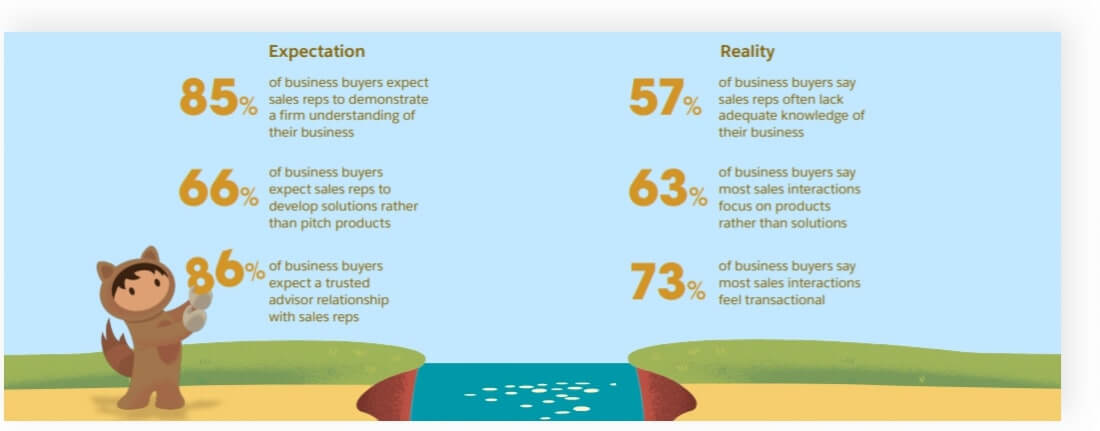
Expectation vs. Reality: 85% of customers expect sales reps to clearly understand their needs, and 57% say sales reps lack knowledge about their customers’ businesses.
Convenience rules
All customers value convenience, especially the Generation Z. This digital generation wants to be able to order anything with just one tap and get it delivered.
Keep this in mind developing products for Gen Z. They like experimenting with how they do their shopping. Self-service portals are getting more popular along with AI-based innovations and other automated solutions.
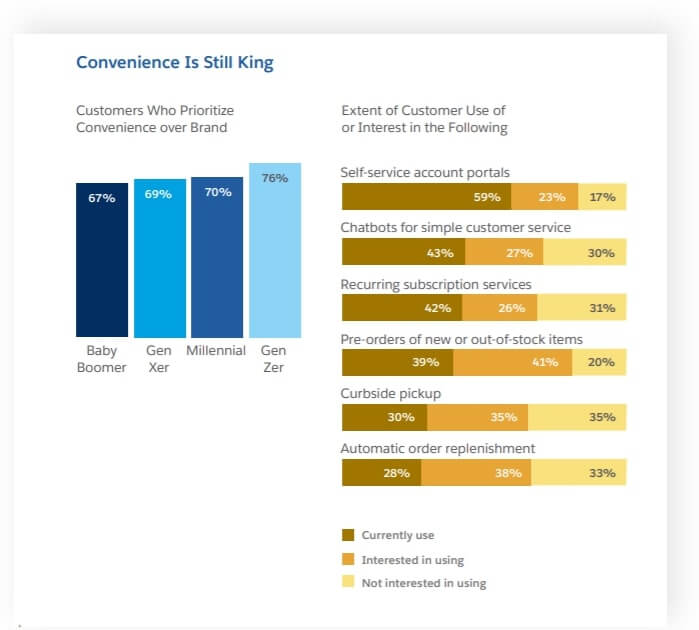
The above graph shows that convenience is key for most millennials (70%) and gen Z users (76%). Wondering how you can ensure this convenience? Use all available digital channels, from chatbots to automatic ordering.
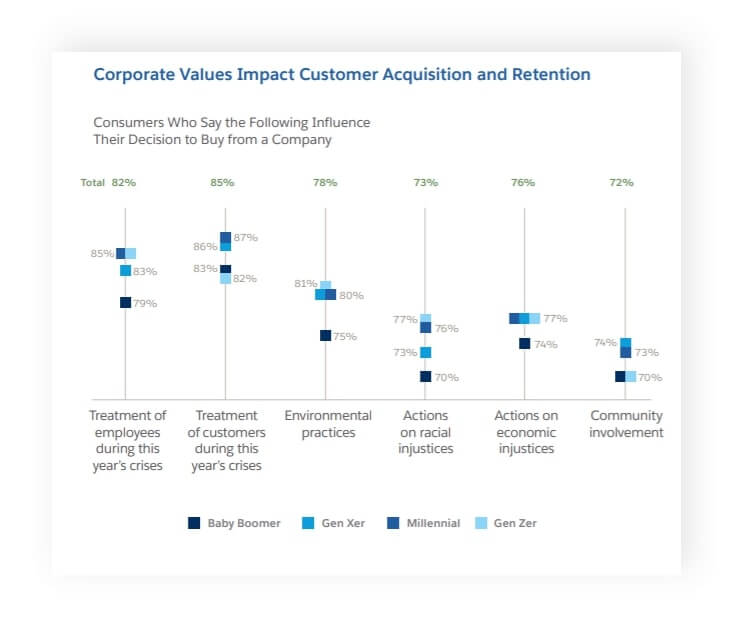
Social responsibility is another advantage in terms of your customer interactions. If you adhere to high standards, engage in economic politics, and pay attention to your employees — customers will love you.
App Annie, State of mobile 2021
How did mobile evolve in 2020?
- the number of app installs grew by +7%;
- people spent 20% more in app stores compared to 2019;
- smartphone screen time grew by +20% and reached 4,2 hours;
- businesses spent 26% more on in-app ads;
- mobile tech raised 27% more venture investments.
What do these figures tell us? Ultimately, phones are replacing desktops and become the leading proxy between the business and the customer.
The authors of the report claim 2020 to be the year of the mobile boom as the industry skyrocketed by 2-3 years ahead.
Read also: The best way to collect emails this year [tested by experts]
Mobile conquered TV streaming
The average screen time now exceeds 4 hours and 10 minutes which is 20% more than in 2019.
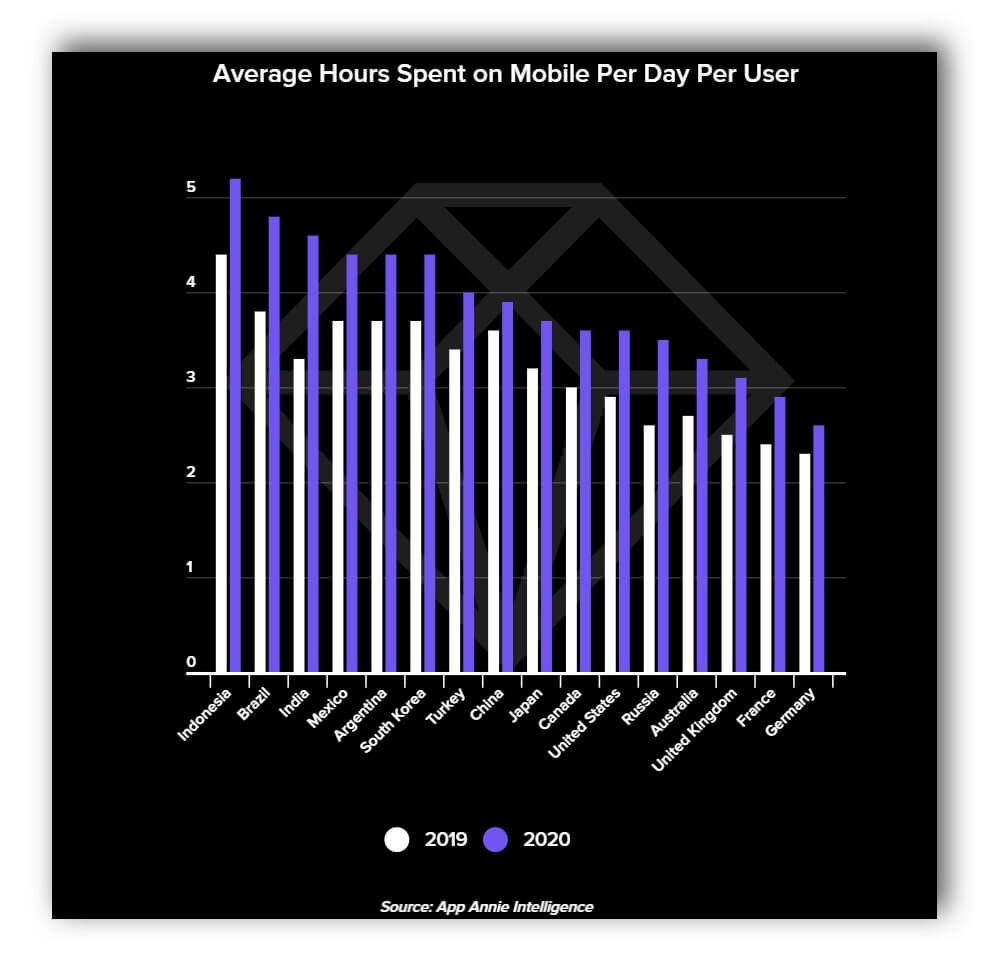
The pandemic greatly influenced streaming apps. Users preferred to view videos in the background or broadcast their content even at home with a TV beside them.
The report authors predict that in the new, post-covid reality, average users in the USA, South Korea, and Great Britain will download 85%, 80%, and 60% more video streaming apps, respectively, compared to the pre-pandemic times.
Social media: TikTok won them all
The average time spent on social media in 2020 increased in all apps compared to the 2019 value, but TikTok is still the leader. The report authors expect TikTok to reach 1,2 bln active users by 2021.

In the USA, the most popular apps are Facebook, TikTok, Instagram, Facebook Messenger and WhatsApp Messenger.
Interesting to note that the average monthly time spent per user on TikTok grew faster than nearly another app that was analyzed.
What about streaming platforms?
YouTube is the leader among streaming apps. It ranks first by the time users spend watching videos. People spend 3x more time than in other streaming apps — 21 hours monthly.
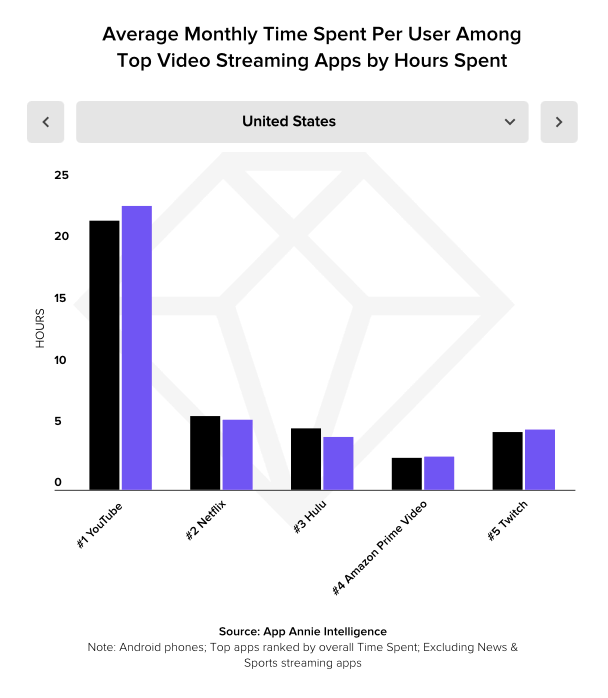
Retail
The M-commerce boom is changing user behavior. 2020 is the year of mobile shopping. Mobile shopping on Android grew by 30% YoY. Time spent on shopping via smartphone increased by 45%, if we don’t take China into account.

USA citizens spend more time on Shopping Apps than other countries in the Americas. No wonder, that the peak of the active time was on the Black Friday sale — on this day, all the Android users spent 70M hours in Apps.
Instagram is the world’s leader in social commerce
Instagram and Pinterest are two apps whose installs grow by 20% and 50% YoY, respectively. Social commerce is the global market whose value will reach 2 trillion dollars by 2024 as it allows you to shop right then and there.
Mobile marketing and advertising
Mobile advertising grows yearly. In the USA, advertisers spent 95% more on in-app ads.
Interstitial Ad showed the biggest growth — users couldn’t miss this.
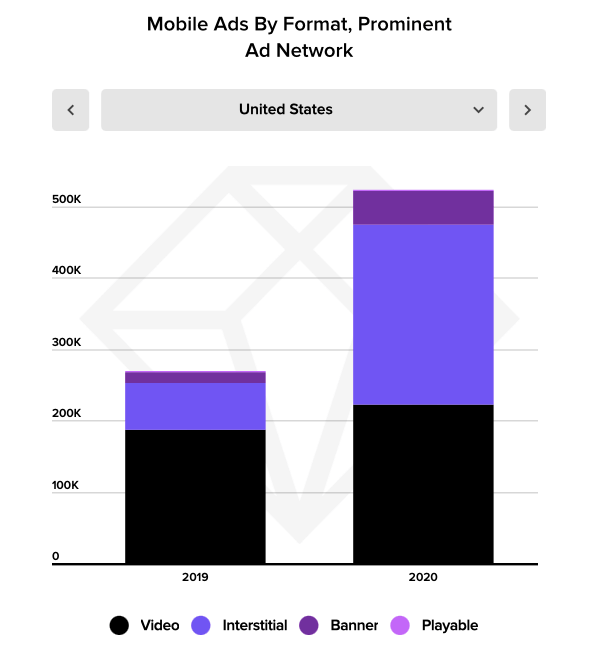
- Video ads became even more popular than in 2019: 221K ads in 2020 vs. 186K in 2019.
- Interstitial Ad showed dramatic growth. In 2019, there were only 66,3K such ads, while in 2020 over 252K.
- Banners also showed growth: 15K ads in 2019 vs. 46K ads in 2020.
Be careful about interstitial ads as they are annoying for some users. Google even pessimizes websites with interstitial ads in search results.
Read also: Capture emails from website visitors with Pop-ups
New organic traffic opportunities
In a nutshell — adjust your content and ads to large news hooks in advance.
For example, users show a growing demand for Black Friday offers even in October as they start to look for special offers. This is a great way to acquire organic traffic and generate profits.
Business applications are growing, too
Time spent in business apps is growing year-over-year. In Q4’2020, this value increased by +275% compared to previous years.
The corona crisis greatly affected this. Lots of people started to work remotely, and they not only find business apps convenient, they actually need to use them.
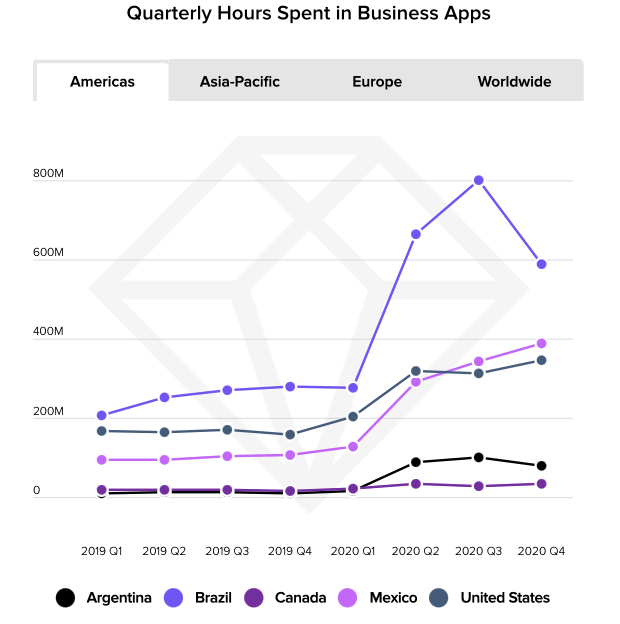
The graph clearly shows a quarterly leap of the time spent in business apps at the very beginning of the COVID-19 pandemic.
Top-10 Apps in the USA by the number of active users:
Google Play store:
- Google Chrome
- Facebook Messenger
- Youtube
- Snapchat
- Gmail
- TikTok
- Messages
App Store:
- Robinhood
- TikTok
- Webull
- YouTube
- Coinbase
- Cash App
- Snapchat
Key takeaways
The year 2020 has become a challenge for businesses worldwide. Challenges breed opportunities, and that’s what companies need to evolve and develop. Companies now acknowledge that customers are their best friends no matter if it’s a crisis or not. People want to trust businesses and expect to connect emotionally and conveniently with companies. In turn, they can become brand ambassadors. Innovations, the strategic approach to data management, and the new level of personalization can help companies gain the trust and positive attitudes of customers.
Read more
- 10 Best Live Chat Software for Customer Support
- 10 Best Customer Service Chatbot Platforms to Level Up the Work
- How to create a user journey online map for your online school students [4 free templates]
- Increase Customer Support Efficiency With 15 Best Knowledge Base Tools
- Chatbot Guide: What can a chatbot do for your customers 24/7



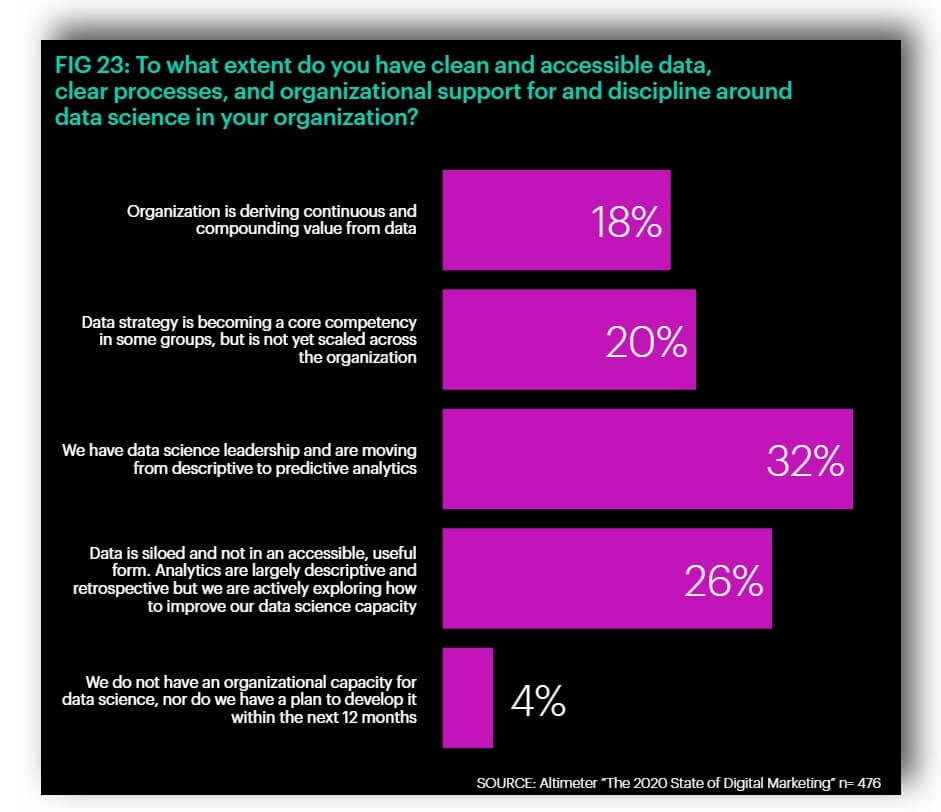











![Sales and Marketing Automation: How to align their workflow to 2x revenue [Dashly example]](https://www.dashly.io/blog/wp-content/uploads/2021/06/IMG_1074-1100x471-1-720x308.jpg)

